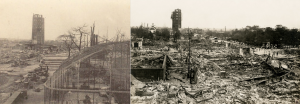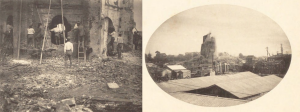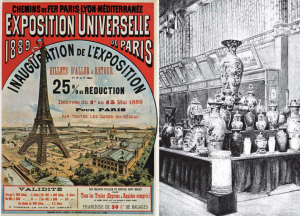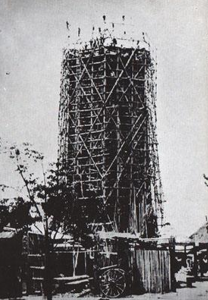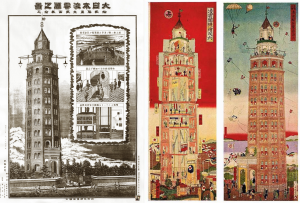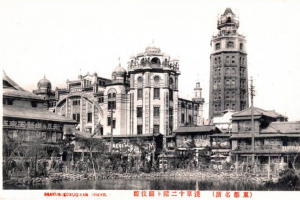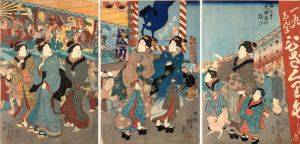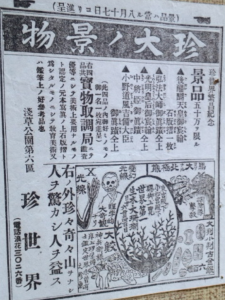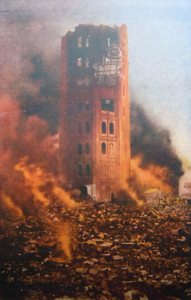 The outer structure of Ryōunkaku still standing strong amidst rubble and fires in Asakusa Park shortly after the 1923 Great Kantō Earthquake. Source.
The outer structure of Ryōunkaku still standing strong amidst rubble and fires in Asakusa Park shortly after the 1923 Great Kantō Earthquake. Source.
by Jing Long Wee
Scene 1
September 22nd, 1923. Once again, debris closes in on Asakusa Park, Tokyo. This wasn’t another earthquake — we just had one three weeks ago.[1] No, people knew what to expect from announcements in newspapers and flyers that warned them to steer clear of Asakusa Park that Saturday.[2] Military engineers clutched dynamite sticks in their hands, and in the early morning, began the arduous process of bringing down whatever remained of Japan’s first skyscraper, the Ryōunkaku.[3] If only the building wasn’t built so strongly. If only everything had obediently crumbled to the ground when the earth shook, just like the rest of Asakusa (see Figures 1 & 2).[4]
Figure 1: “Partial collapse of Jūnikai”
Figure 2: The rest of Asakusa reduced to rubble
But Ryōunkaku would not have this. It was one stubborn tower that was, from its birth, determined to stand out unsympathetically, even in times of disaster. Its insides were completely emptied out by the quake, but most of its red-brick, twelve-story tall, outer structure remained awkwardly intact.[5] Reduced to a shell, it was damaged beyond repair. It was thoroughly vacated. But still, this poster-child of Japan’s modernity wasn’t ready to give up its symbolic aura and place in the city. It was still the tallest structure in Tokyo, if not, in the whole of Eastern Japan. And so, it took an entire day, and the entire 7th Battalion of military engineers, to take it down with explosives (see Pictures 3 & 4).[6]
Figure 3: “Activities of troops before detonation of tower”
Figure 4: “The moment of Jūnikai’s detonation”
Despite the warning, many people still flocked to the debris-covered Asakusa to observe the tower’s gradual, but certain, demise. The tower was proud. Once again, it was the spectacle. The center of attention.
Scene 2
May 5th, 1889. The Exposition Universelle opens in Paris. The two main highlights of the fair are the newly unveiled 300-meter Eiffel Tower (Picture 5), and the exotic, 80-member-strong Javanese gamelan ensemble that the Dutch government had fetched from their East Indies.[7] Never mind that Japan’s pavilion at the fair — a simple one-storey temple-like structure featuring its traditional ceramic arts, received less fanfare (than the newly unveiled Eiffel Tower or Javanese gamelan ensemble) (Picture 6).[8] Meiji officials thought the world would be equally amazed the following year when Japan unveiled its own ‘Eiffel Tower’. Construction for Ryōunkaku, or the “Pavilion that Soars Above the Clouds”, was almost complete. Although only one-sixth of the Eiffel Tower’s height, the 52-meter octagonal tower was enough to be the tallest building in Japan. The tower was to symbolise Japan’s successful attempts at modernization, and so, from its design to construction, Ryōunkaku was made to be ‘Western’ through and through. In line with the Meiji government’s habit of haphazardly hiring foreign advisers, one Scottish sanitary engineer, William Burton was entrusted with designing the building in 1887, not long after he arrived in Japan for the first time.[9]
Figure 5 (left): Highlights of Paris 1889 Exposition Universelle;
Figure 6 (right): Traditional ceramic arts in Japan’s Pavilion at 1889 World Fair
In the early stages of construction, the tower was no different from traditional Japanese houses. Everything — from its foundation, pillars to flooring — was constructed out of wood in various forms: planks, straw, tree bark, paper, nails and so on.[10] Laborers cautiously climbed atop winding wooden staircases, carrying woods of various shapes and sizes on their backs. Suspended above ground, they toiled away, meticulously piecing together pre-cut wood boards. And all of this building activity went on within a wooden enclosure of grid-like support frames and beams — which stabilised the emergent structure (and its craftsmen) as it grew from within — like a foetus (Picture 7).[11] Wood was in abundance, and people knew how to work with it. But wood was falling out of fashion — it was too antiquated, too everyday, and too Japanese. And so in this supposedly ‘Western’ building, wood was to be invisible from the outside, invisible to the public.[12]
Figure 7: Wooden support structure.
Later on in the construction, when it seemed like the basic structure that was nestled within had finally matured, laborers slowly dismantled the wooden womb, replacing it with a shell of bricks — thick, bright-red, almost-too uniformly and almost-too neatly shaped.[13] On the outer layer of this shell, these bricks were attached to one another by laboriously-mixed concrete which threatened to turn solid as it was passed around in a bucket along a human chain of laborers into the sky. On the hidden inside of the shell, however, thick but ductile metal wires shoddily strapped together bricks. Against the pink cherry blossoms come spring, lush greenery come summer, trees shedding orange come autumn and white barrenness come winter, this bright-red shell stood out in Asakusa Park throughout the year (Figure 8).[14]
Figure 8: Ryōunkaku stands out against Asakusa Park’s naturescape.
Figure 9: Illustration showing Ryōunkaku’s arc lighting at night.
The tower was so hungry for attention, it seems, that all of its 176 long glass windows were polished so perfectly until they blinded onlookers with sun during the day, and harsh fluorescent indoor lighting at night (Figure 9).[15]
Scene 3
November 10th. Or what is celebrated as Elevator Day in Japan today. But it really should have been November 11th. Because in 1890, the opening of Japan’s first electric elevator within Ryōunkaku was pushed back by one day when guests-of-honor could not make it on the tenth.[16] The elevator dipped ever more slightly as it was loaded up with people, one-by-one. Once the elevator doors were completely sealed, the motors buzzed noisily and sent vibrations throughout the body of the elevator. Gears spun, sometimes creaking, pulleys hoisted, sometimes squeaking, and metal ropes tugged at the elevator with all their might (Picture 10).[17] On its way from the second to seventh floor, the elevator passes by some forty stores selling a standard assortment of luxury goods from all around the world — European timepieces, lamps, thermometers, writing equipment, umbrellas and so on and so forth.[18] On the eighth floor, prying open the elevator doors, one steps into a spacious lounge, and adjacent to the lounge is a musical hall where Western music concerts are held, and an art exhibition space where photographs of geisha are displayed (Picture 11).[19]
Figure 10: Depiction of Ryōunkaku’s electrical elevator (bottom frame) in a promotional flyer.
Figure 11: Illustrated, internal floor-by-floor layout of Ryōunkaku
If most visitors weren’t already overwhelmed by their newfound sense of vertical freedom as their bodies were ‘magically’ lifted into the air in a metal box[20], they were surely in for a transformative visual experience as they climbed up the stairs, from the eighth floor, up to the observation decks on the tenth, eleventh and twelfth floors. Once there, behind the safe transparency of long glass windows, all of Tokyo — and on a clear day, even Fuji-san, and even all of Japan — could be seen. Like the Eiffel Tower, Ryōunkaku satisfied the late 19th century desire for a new way of seeing: seeing from above. It enabled visitors to reimagine Tokyo and Japan. They not only grasped however much they could of the literal, messy metropolitan agglomeration that now appeared clearly before their eyes, but also took in Japan’s newfound position in the world — elevated, modern and civilised.
Scene 4
Postcards immortalised Ryōunkaku from its birth in 1890. On these small, handy pulpous surfaces, the immaculately printed and vibrantly coloured tower took up a permanent, material and endlessly reproducible presence for itself as the de facto symbol of Japanese modernity.[21] Yet these postcards mostly circulated amongst curious tourists and visitors to the city, and never found themselves in the hands of Tokyo’s own metropolitan residents. For Tokyoites who had seen their fair share of four to five-storey buildings in the city (Indeed there were relatively tall Buddhist pagodas even in the same Asakusa district), the tower was but just another regular structure, only just two to three times taller than usual (Picture 12).[22] For them, the tower did not float — contrary to what is suggested by its official name, Ryōunkaku, and its allusion to clouds and to the celestial heaven-scape. As the hype surrounding the tower died down soon after its opening, and as many Tokyoites found it enough to ascend the tower once and never again after, Tokyoites came to refer to the tower as simply ‘Jūnikai’, or literally ‘twelve steps’ or ‘twelve floors’.[23] The tower may be the tallest in Japan, but even it was finite — spared neither from people’s short-lived attention spans, nor from the common, worldly denomination for measuring height: ka-i. The magical incantation that made the tower mundane, trivial, and not that magical after all. (whispers) Ka-i.
Figure 12: Tower surrounded by relatively tall structures.
Scene 5
Less than a year after the big earthquake. Famed writer Akutagawa Ryūnosuke does not mention ‘Jūnikai’ or ‘Ryōunkaku’ even once in his nostalgia-charged piece on Asakusa.[24] For Akutagawa, Asakusa at the turn of the 20th century was, instead, all about its misemonokoya (Picture 13). Mi-se-mo-no-ko-ya — that is, the little exhibition houses that dotted Asakusa streets, whose vibrant street-level activities disappear from sight and from hearing atop the ‘Ryōunkaku’.[25] In these houses, visitors pay a small sum to enter the koya, or small house, and they did so to see misemono, or things worth showing and seeing. Vague. Very vague. But it is precisely this vagueness that enhanced the appeal of misemonokoya. What was worth seeing in these informally organised spaces was forever changing; and the offerings of one misemonokoya differed drastically from that of another just down the street.
Figure 13: Edo-period woodblock prints depicting misemonokoya.
Equally vague and unclear are the historical beginnings of misemonokoya. From very early on, it appears that ‘things that were worth seeing and showing’ in misemonokoya were constituted precisely in opposition to more orthodox and disciplined forms of aesthetic practices. In the early 1600s, for instance, misemonokoya in Edo, or modern Tokyo, housed any entertainment form that was not classical dance-drama in the kabuki tradition.[26] This included casual dancing, singing, puppet shows, and magic shows. Forever the negativity to that which is considered ‘high culture’, misemonokoya are highly versatile spaces with indeterminate contents. By the early 20th century, the misemonokoya had drawn inspiration from other entertainment forms, like zoos, circus, and art and museum galleries.[27]
And so visitors to misemonokoya in Asakusa could see rare animals. Or maybe not. Maybe just pictures of animals. Well, one wouldn’t be sure until one paid and entered. And this uncertainty was perhaps the fun of it all. Visitors could also maybe see acrobatic performers. Or their pictures. Or not. Or realistic anthropomorphic sculptures. Or not. Or historically significant material artifacts like classical coinage. Or not. Or more commonly, a mixture of all of the above (Picture 14).[28] Or not… Misemonokoya were unpredictable and fun, while Jūnikai — with its one-time-is-enough observatory decks, and with its standard, yet unnecessarily expensive shopping and entertainment options, was not.
Figure 14: Flyer to larger-than-average misemonokoya “Chinsekai” (Rare World), dated between 1902 and 1909.
Scene 6
Among the people who had gathered before whatever was left of the Ryōunkaku on the morning of September 22nd, 1923 to watch its passing — some of them, undoubtedly, were mourning and sobbing away at the impending loss of Japan’s modernity. To these people, the tower was thankful. And it died, I think, a raucous, but ultimately peaceful death. Authors and artists were always fascinated with the entertainment district that is Asakusa. Though no one really saw that tall, bright-red tower that rose from Asakusa, as a worthy-enough subject for writing. It was only in the late 1920s, when the Jūnikai had been forcefully laid to rest for over 6 years, when most of Asakusa had been reconstructed, and when most of Tokyo and eastern Japan had been rebuilt, that the tower — now a spectral trace, made its debut on the literary page.
On these new Showa-era pulpous surfaces, however, the tower was a sign of an outmoded Meiji-era style of modernity, whose death, in retrospect, could not have been more welcomed. Jūnikai was the ‘symbol of old Asakusa’. The new Asakusa of the 1930s is to be about ‘eroticism and nonsense and speed and comic-strip humor of current event and jazz songs and ladies’ legs and… and… and… (gasps),’ writes Yasunari Kawabata.[29] He adds: “The giant holding his ground as the last defence of the age of Meiji brick had fallen disemboweled, and then came the age of ferroconcrete, the age of Jazz, the talkie, the proletarian literature, the … the … the…’[30]
The tower must have long known that it will one day fall. And when it did fall, it was pleased, perhaps even pleasantly surprised, that it had lived that long. Only four years after its opening, the tower narrowly escaped death. Tremors in 1894 had significantly weakened the tower’s structure. Officials, then however, chose to save it, and promptly reinforced the tower structure with steel griddles.[31] The tower’s first encounter with death, it seems, came much earlier. Indeed, there is a sense that the tower should not have been built in the first place. And so, we could say that the spectre of its demise first flashed up precisely at the same moment when its ill-advised design and construction began in the late 1880s. When Meiji bureaucrats entrusted the tower to a Scottish who wasn’t especially knowledgeable, it seems, of Japan’s proclivities to tremble…
Selected Bibliography
Akutagawa, Ryūnosuke . “Kyūpiddo (Cupid),” in Yajin seikeiji (Livelihoods of ‘unrefined’ people). 1924. Accessed at: http://dl.ndl.go.jp/info:ndljp/pid/977224/97?viewMode=
Anda, Kaori. “Regarding Java dance and music at the 1889 Paris World Fair,” Southeast Asia Research (Tōnan ajia kenkyū, March 1999) 36 (4): 505-524. Accessed at: https://repository.kulib.kyoto-u.ac.jp/dspace/bitstream/2433/56696/1/KJ00000132093.pdf.
Hiraishi, Noriko. “A Fallen Landmark and the Literary Imagination: The Ryounkaku in Modern Japanese Literature,” Wenshan Review of Literature and Culture (June 2013) 6(2): 93-104. Accessed at: http://english.nccu.edu.tw/files/archive/127_44cb2801.pdf
Kantō Martial Command Forces (ed.) Collection of Photographs from Big Taisei 12 September Earthquake (大正12年9月大回震災写真集, Taisei Jūninen kugatsu taikai shingai shashinshu). Kaisansha: 1923. Accessed at: http://dl.ndl.go.jp/info:ndljp/pid/1872746.
Kawabata, Yasunari. The Scarlet Gang of Asakusa. Trans. Alisa Freedman. Berkeley: University of California Print, 2005.
Wittner, David G. “The Mechanization of Japan’s Silk Industry and the Quest for Progress and Civilization, 1870-1880,” in Morris Low (ed.), Building a Modern Japan. New York: Palgrave Macmillan (2005), 135-159.
Yomiuri Shimbun.
1890, Apr. 8 (correction on Apr. 17). “12-storey brick Ryōunkaku completed.”
1890, Aug. 16. “Bricklaying up until 10th floor done, beginning work on the remaining two floors above.”
1890, Oct. 27. “Delayed opening ceremony; Elevator malfunctioned on 25th October.”
1890, Oct. 28. “Further delays to opening ceremony; fissures found in brick structure where elevator was installed; tower to open after repairs.”
1890, Nov. 3. “Further delays to opening of tower; rotation of the elevator motor spins too fast and poses danger to women and children passengers.”
1890, Nov. 11. :Opening ceremony of Ryōunkaku delayed again.”
1890, Nov. 12. “Ryōunkaku’s opening; thousands of red light lit up at night, casting a layer of brilliance (over Asakusa).”
1891, Jan. 13. “Booming demand for Ryōunkaku postcards, already 100,000 sold.”
1891, Jul. 5. “100 Geisha Photographs to be Displayed for Visitors to vote on.”
1891, Jul. 12. “Standing of geishas in monthly photo beauty competitions to be revealed every week; Attractive prizes for winner.”
1894, Jun. 22. “Report on Tokyo Earthquake: Cracks in Ryōunkaku and others…”
1894, Aug. 25. “Ryōunkaku’s Shōkōshitsu begins operations.”
1901, Mar. 14. “Asakusa Ryōunkaku sustains losses; owners investigate.”
1923, Sept. 22. “Forced demolition via detonation to begin; Do not be alarmed at earth-shattering explosion sounds (爆発作業はじまる 物凄い爆音に驚くな、Bakuhatsu sagyō hajimaru; monosugoi bakuon ni odorokuna).”
[1] A magnitude 7.9 earthquake lasting between 4 to 10 minutes struck Tokyo and the Eastern coast of Japan on 1st September 1923 at around 11:58am. Today, it is known as the 1923 Great Kantō earthquake. The city of Tokyo was reduced to a wastefield of collapsed structures and rubble. Many large fires broke out throughout the city and developed into massive firestorms. It took close to two days for all fires to be put out, i.e., on late morning of 3rd September. False rumors spread that Koreans were taking advantage of the disaster, committing arson and robbery, possessing bombs, and poisoning wells. Consequently, many Koreans (as well as Chinese) were killed by mob violence.
[2] For instance, see “Forced demolition via detonation to begin; Do not be alarmed at earth-shattering explosion sounds (爆発作業はじまる 物凄い爆音に驚くな、Bakuhatsu sagyō hajimaru; monosugoi bakuon ni odorokuna),” Yomiuri Shimbun (Tokyo, Japan), Sept. 22, 1923.
[3] Ibid.
[4] Refer to image (Picture 1) titled “Partial collapse of Jūnikai” (十二階の崩壊, Jūnikai no hōkai) in page 84 of Collection of Photographs from Big Taisei 12 September Earthquake (大正12年9月大回震災写真集, Taisei Jūninen kugatsu taikai shingai shashinshu). (edited by Kantō Martial Command Forces), Published by Kaisansha in 1923. Accessed through http://dl.ndl.go.jp/info:ndljp/pid/1872746. See also Picture 2 taken from http://showcase.meijitaisho.net/entry/ryounkaku_11.php
[5] Newspaper reports repeatedly emphasised that the tower was made of bricks even before it opened. See for instance article “12-storey brick Ryōunkaku completed,” Yomiuri Shimbun (Tokyo, Japan), Apr. 8 (Apr. 17 correction), 1890, and article “Bricklaying up until 10th floor done, beginning work on the remaining two floors above”, Yomiuri Shimbun (Tokyo, Japan), Aug. 16, 1890.
[6] Refer to images (Pictures 3 & 4) titled “Activities of troops before detonation of tower ” (十二階 の爆破前に於ける工兵の作業, Jūnikai no bakuhatsuzen ni okeru kōhei no sagyō) and “The moment of Jūnikai’s detonation” (十二階の 爆破の瞬間(工兵第7大隊), Jūnikai no bakuhatsu no shunkan (kōhei daishichi daitai)) respectively, in page 87 of Collection of Photographs from Big Taisei 12 September Earthquake (大正12年9月大回震災写真集, Taisei Jūninen kugatsu taikai shingai shashinshu). (edited by Kantō Martial Command Forces), Published by Kaisansha in 1923. Accessed through http://dl.ndl.go.jp/info:ndljp/pid/1872746
[7] See Kaori Anda, “Regarding Java dance and music at the 1889 Paris World Fair,” Southeast Asia Research (Tōnan ajia kenkyū, March 1999) 36 (4): 505-524. Accessed at: https://repository.kulib.kyoto-u.ac.jp/dspace/bitstream/2433/56696/1/KJ00000132093.pdf.
[8] See image showing the interior of Japan’s pavillion at the 1889 World Fair at: https://i.pinimg.com/originals/e1/d9/f8/e1d9f8528b5346aaa8217c4509ae26b0.jpg
[9] Read more about Meiji’s government habit of haphazardly hiring foreign advisers in David G. Wittner. “The Mechanization of Japan’s Silk Industry and the Quest for Progress and Civilization, 1870-1880,” in Morris Low (ed.), Building a Modern Japan. New York: Palgrave Macmillan (2005), 138.
[10] See “Bricklaying up until 10th floor done, beginning work on the remaining two floors above”, Yomiuri Shimbun (Tokyo, Japan), Aug. 16, 1923.
[11] Ibid., see also image of wooden support frames at: https://i2.kknews.cc/SIG=1gdrtc9/37rp0004q05nq39o2085.jpg
[12] See David G. Wittner. “The Mechanization of Japan’s Silk Industry and the Quest for Progress and Civilization, 1870-1880,” in Morris Low (ed.), Building a Modern Japan. New York: Palgrave Macmillan (2005), 135-159. Wood’s status as ‘traditional’ materials, as well as its unsophisticated appearance made them unacceptable (in demonstrating ‘modernity’) from an ideological perspective (Wittner, p. 153). Meiji bureaucrats appear to have taken up Victorian standards, which considered stone and brick buildings as a measure of ‘civilisation’ (George Clancey, as quoted in Wittner, p. 145). The Meiji government’s approach to civilisation and modernity was an exterior one, i.e., focusing on the physical manifestation or facade of an architecture, as opposed to its interior (Motoyama Yukihiko, as quoted in Wittner, p. 145). To this end, bricks possessed a symbolic aura connoting ‘modernity’.
[13] See “Bricklaying up until 10th floor done, beginning work on the remaining two floors above”, Yomiuri Shimbun (Tokyo, Japan), Aug. 16, 1923.
[14] Ryōunkaku was a popular spot for cherry-blossom (in Asakusa Park) viewing in early spring. See, for instance, the tower being featured in a guidebook for cherry-blossom viewing: http://dl.ndl.go.jp/info:ndljp/pid/889212/20?viewMode=
[15] Ryōunkaku was also unique in that it was equipped with then- what was considered to be relatively advanced electrical lighting systems. Arc lights on the balcony of the ninth floor, for instance, shone intense fluorescent light into the night sky. See illustration: http://www.tanken.com/ryoun3.jpg; also see “Ryōunkaku’s opening; thousands of red light lit up at night, casting a layer of brilliance (over Asakusa),” Yomiuri Shimbun, Nov. 12, 1890.
[16] See “Opening ceremony of Ryōunkaku delayed again,” Yomiuri Shimbun (Tokyo, Japan), Nov. 11, 1890. It is important to note that the tower was originally first supposed to be open in early October (see “The exterior surface of Ryōunkaku completed; opening ceremony scheduled for early next month in Asakusa Park,” Yomiuri Shimbun, Sept. 23, 1890). However, the opening ceremony was repeatedly pushed back from early October to 28, 29 October, then to 1 November, then to 2 November, and then finally to 10 November and then 11 November, owing to a series of problems with the installation of the electrical elevator. For instance, on 25 October, the elevator malfunctioned during a test run. (see “Delayed opening ceremony; Elevator malfunctioned on 25th October”, Yomiuri Shimbun, Oct. 27, 1890). On 27 October, engineers discovered fissures in the internal structure of the tower, following the installation of the electrical elevator. (see “Further delays to opening ceremony; fissures found in brick structure where elevator was installed; tower to open after repairs,” Yomiuri Shimbun, Oct. 28, 1890) On November 2, the speed of the elevator was deemed too fast and therefore dangerous for female and children passengers. (see “Further delays to opening of tower; rotation of the elevator motor spins too fast and poses danger to women and children passengers,” Yomiuri Shimbun, Nov. 3, 1890.)
[17]See depiction of Ryōunkaku’s electrical elevator in a promotional flyer at http://showcase.meijitaisho.net/entry/ryounkaku_02.php
[18]I speculate here that the goods sold in Ryōunkaku’s international marketplace were similar to those sold in Ginza’s foreign departmental stores. For standard assortment of foreign luxury items sold in Japan, refer to: http://www.virtualmuseum.ca/edu/ViewLoitLo.do;jsessionid=012B0B1671310E4E88F0E6BD8B56208D?method=preview&lang=EN&id=12954
[19] An illustrated, internal floor-by-floor layout of Ryōunkaku can be found here: https://www.pinterest.jp/pin/566046246898151768/; Geisha photography exhibition cum competition was held in the tower every month beginning from July 1891. There, visitors vote for the most beautiful geisha; and an assortment of attractive prizes are awarded to both a few lucky voters and the winning geisha. See “100 Geisha Photographs to be Displayed for Visitors to vote on,” Yomiuri Shimbun, Jul. 5, 1891. See also “Standing of geishas in monthly photo beauty competitions to be revealed every week; Attractive prizes for winner,” Yomiuri Shimbun, Jul. 12, 1891.
[20] See “Ryōunkaku’s Shōkōshitsu begins operations,” Yomiuri Shimbun, Nov. 25, 1890. Interestingly, the article refers to the elevator literally as an ‘ascending and descending room.’ Over the weekend on 22nd and 23rd November, over 5000 people flocked to Ryōunkaku to experience the elevators for themselves. Those interviewed found the ‘room’ strange, yet magical.
[21] See for instance, “Booming demand for Ryōunkaku postcards, already 100,000 sold,” Yomiuri Shimbun, Jan. 13, 1891. Other merchandise like miniature figurines of the tower, prints and paintings of the tower were also mass-produced and popularly received when the tower first opened.
[22] Jūnikai was surrounded by many relatively high buildings (4-5 storeys). See for instance: https://i.pinimg.com/564x/d2/c8/e5/d2c8e579e0606537f6ef6e51a7f5ed13.jpg
[23] Visitor numbers to Ryōunkaku fell steadily after 1895, according to newspaper coverage on the tower. In early 1901, the tower started making losses, and business owners frantically gathered to think of ways to reinvigorate the tower. See “Asakusa Ryōunkaku sustains losses; owners investigate,” Yomiuri Shimbun, Mar. 14, 1901. In the 1890s and 1900s, many people commited suicide by jumping off the observation decks of the tower.
[24] Ryūnosuke Akutagawa. “Kyūpiddo (Cupid),” in Yajin seikeiji (Livelihoods of ‘unrefined’ people). 1924. Accessed at: http://dl.ndl.go.jp/info:ndljp/pid/977224/97?viewMode=
[25] Ibid., 189.
[26] See: https://edo-g.com/blog/2016/08/misemono_goya.html
[27] Ibid.
[28] The objects/items/activities listed here are taken (1) from Atukagawa’s writings on misemonokoya in “Cupid”, and (2) from a flyer for “Chinsekai” (Rare World), a larger-than-usual misemonokoya in Asakusa. The flyer is dated Meiji 35 to Meiji 42 (i.e., 1902 to 1909). Access scan of flyer here: http://saijo-noboru.c.blog.so-net.ne.jp/_images/blog/_e82/saijo-noboru/image/2014-08-02T11:17:03-738f9.jpg
[29] Yasunari Kawabata. The Scarlet Gang of Asakusa. Trans. Alisa Freedman. Berkeley: University of California Print, 2005, 31. (As quoted in Noriko Hiraishi, “A Fallen Landmark and the Literary Imagination: The Ryounkaku in Modern Japanese Literature,” Wenshan Review of Literature and Culture (June 2013) 6(2): 101)
[30] Ibid., 111.
[31] See news reports like “Report on Tokyo Earthquake: Cracks in Ryōunkaku and others…,” Yomiuri Shimbun, Jun. 22, 1894; “Repairs for Ryōunkaku damaged by Earthquake,” Yomiuri Shimbun, Aug. 25, 1894.
